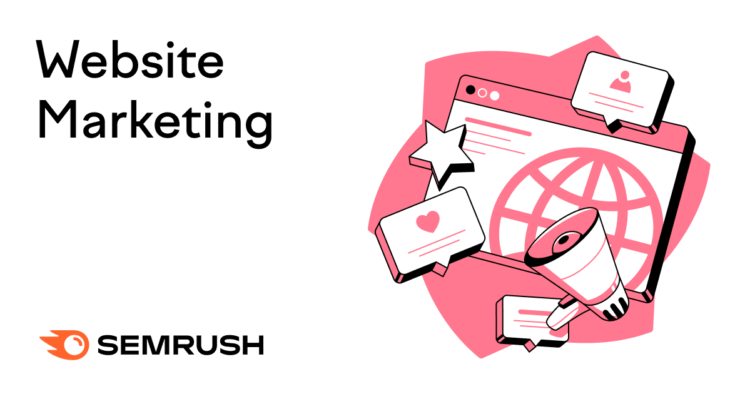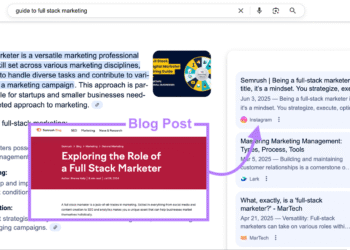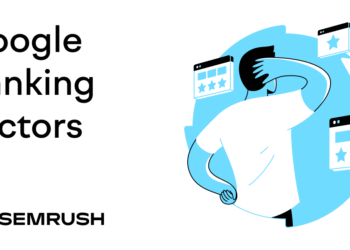What Is Website Marketing?
Website marketing is the process of promoting your website to attract more visitors to it using methods like search engine optimization (SEO) and content marketing.
Before we go over the variety of techniques you can use to market your website, let’s discuss how website marketing can help you grow your business.
Why Do You Need to Market Your Site?
Effectively marketing your website ensures you actually capture prospects’ attention, so you can build relationships that translate to business results.
Thoughtfully promoting your site can:
- Increase your visibility: Different tactics can help your website appear in places like search engines, social media platforms, and AI tools. And that visibility translates to more website visits.
- Educate prospects about what you do: Website marketing provides helpful information about your products/services, business, and industry. Which influences whether prospective customers ultimately choose you.
- Drive business results: Consistently appearing across the web and building trust with potential customers often translates to tangible results
9 Techniques to Use in Your Website Marketing Strategy
Many businesses use these website marketing tactics, so they’re likely to help your website as well:
1. Search Engine Optimization
Search engine optimization (SEO) is the process of improving your website’s visibility in search engine results without relying on paid ads.
In the modern marketing world, this involves optimizing for:
- Traditional blue links in search engine results pages (SERPs)
- Traditional SERP features like featured snippets, People Also Ask boxes, and knowledge panels
- Google’s AI Overviews
When your website ranks higher or appears in AI-powered features, you have a better chance of attracting potential customers. Which can help you generate more leads and sales.
For example, travel gear brand Béis Travel increased ranking (SERP position) for the keyword “best tote bags for work,” according to Semrush’s Organic Research tool. The “/work-totes” page went from position 4 to position 1—driving an estimated organic traffic increase of 265 visits per month.

Per Traffic Analytics, Béis Travel’s site converts 1.23% of visitors into customers.

Given the average price of a product on the “/work-totes” page is around $140, this means a ranking increase from position 4 to position 1 could result in an estimated $456 of extra business per month. From a single keyword.
To improve your site’s SEO:
- Write high-quality content that’s crafted around what users are looking for
- Fix technical SEO issues like slow load times and broken links. And make sure your site works properly on mobile devices.
- Get mentions and backlinks to your site from other trusted websites
- Structure your content so that search engines can better understand it
To write effective SEO content, use Semrush’s AI Article Generator. Just enter a topic to get a more specific idea.
Fill in or modify the parameters and enable the SEO and image enhancements. Then, click “Create article.”

The AI Article Generator will create a full-length draft using Semrush’s live SEO data and your chosen tone of voice. Once it’s ready, refine the draft using the built-in editor.

In the “Improvements” tab, you’ll get suggestions for improving SEO, readability, and tone. Apply the recommended fixes to further refine your draft.

2. Generative Engine Optimization
Generative engine optimization (GEO) is the practice of optimizing your site so that it appears in AI tools like ChatGPT, Google AI Mode, Perplexity, Claude, and others.
Our research suggests that AI search will start driving more traffic to websites than traditional search engines by 2028. Which means this is an increasingly important way to market your website.

Here’s how to optimize your website for AI search tools:
- Build your brand’s authority by getting mentioned by trusted sources like Wikipedia, reputable publications, and widely cited industry blogs
- Thanks in part to Google’s licensing deal with Reddit, Reddit conversations are often used to shape AI answers. So, participate in relevant discussions around your brand, products, or industry.
- Make it easy for AI crawlers to access and understand your content by ensuring it’s well-structured, up to date, and optimized for crawling and indexing
- Publish original content backed by first-party data or unique insights to make your brand stand out
Use Semrush’s AI SEO Toolkit to analyze and improve your brand’s AI presence across multiple platforms.
In the “Narrative Drivers” dashboard, you’ll see your brand’s share of voice and mentions across AI platforms. And be able to compare your visibility against competitors.

The “Perception” dashboard shows the sentiment behind your AI mentions. Along with “Areas for Improvement” to boost your brand sentiment in AI tools.

And the “Questions” dashboard shows you the prompts users are entering into AI tools. So, you can plan your content accordingly.

Further reading: How to Rank in AI Search
3. Search Ads
Paid search ads are paid promotions that appear in search engine results, meaning they often put your site in front of a highly targeted audience.
Search ads typically use a pay-per-click (PPC) model that involves paying a fee each time someone clicks on your ads.
And once you set up and fund paid ad campaigns, your ads can start showing almost instantly. Which can quickly drive visibility, traffic, and even sales.
Here’s an example of a paid search ad on Google:

Search ads can appear on Google’s search results pages in a few ways. And even in Maps.
However, the search landscape has shifted. And AI Overviews often appear above paid ads, which can push your ads further down the page. This may lower their visibility and reduce the chances of getting clicks.

Be aware that visibility from paid ads disappears once you stop running ads, so you need a dedicated budget to keep running ads. And to optimize your campaigns to increase the odds you’ll see a positive return on your investment.
To get the most out of your paid ads budget, do the following:
- Run A/B tests: This involves creating multiple versions of your ads with one small difference in the headline, call to action (CTA), or visuals
- Use smart bidding strategies: Take advantage of Google’s AI-powered bidding options like Target ROAS or Maximize Conversions to improve your ad performance in real-time
- Improve your Quality Score: This score reflects how relevant and useful your ad and landing page are. It’s not used in the ad auction, but improving this value can lead to better placements and lower costs.
- Target the right audience: Use targeting options related to location, age, interests, and search behavior to put your ads in front of people most likely to engage with your business
- Take inspiration from your competitors’ ads: Analyze the ad copy, visuals, and keywords your competitors are using to improve your own ads
The Advertising Research tool lets you easily analyze your competitors’ ads to learn what’s working for them. To use it, enter a competitor’s domain and click “Search.”

Go to the “Ads Copies” tab to view the ads your chosen competitor is running. Look at the competitor’s headlines, descriptions, and keywords to get ideas for your own ads.

4. Organic Social Media Marketing
Organic social media marketing involves using social media platforms to drive people to your site through unpaid efforts.
By establishing your social media presence, you can introduce your brand to more potential customers, earn their trust, and encourage them to visit your site.
For example, cookie company Crumbl uses Instagram to direct potential customers to their website’s order page.

Organic social media marketing involves:
- Creating a social media strategy that aligns with your business goals
- Regularly posting high-quality content on platforms where your audience is most active
- Engaging with your audience through comments, messages, and likes
- Tracking and analyzing performance metrics to see what works best
Organic social media marketing requires time and consistency to see results—especially if you’re trying to establish your presence across multiple platforms. So, use Semrush’s Social Toolkit to manage it all in one place.
Use the Social Poster to plan, write, and schedule posts across platforms using an interactive calendar.

Then use the Social Tracker to monitor competitors’ posting habits and top-performing content and compare it to yours. This helps you identify opportunities to improve your own strategy.

If you need help scaling your social media content, Social Content AI rapidly generates on-brand post ideas, captions, visuals, and hashtags using AI.

5. Social Media Advertising
Social media advertising involves running paid ads on social media platforms and is often used to attract more visitors to your site.
Social ads are typically labeled as “Ad,” “Promoted,” or “Sponsored.”
Here’s an example of a paid ad on Instagram:

And here’s a social media ad on LinkedIn:

Social media ads can show up in users’ feeds, stories, and videos (like Instagram Reels or TikTok). And even as sidebar ads on platforms like LinkedIn. The format depends on your campaign and the platform you choose.
To get the most out of your social media advertising efforts, make sure you:
- Choose the right platform: Pick platforms where your target audience is most active. For example, LinkedIn has a large B2B user base, while Instagram and TikTok are popular among younger audiences who may be prepared to make low-cost purchases.
- Test multiple ad variations: Run A/B tests with different visuals, headlines, and CTAs to see which variations drive the best results
- Pinpoint your target audience: Use targeting options like age, location, interests, and behaviors to put your ads in front of people who are most likely to engage with your business
- Run retargeting ads: Connect with users who’ve interacted with your business. For example, you can show social media ads to people who added items to their carts on your website but didn’t complete the purchase.
6. Email Marketing
Email marketing is one of the best ways to connect directly with your subscribers and drive traffic to your website.
Email puts you in recipients’ inboxes to directly share valuable content, build relationships, and encourage actions like making a purchase.
Check out this email from Cordelia Cruises, a luxury cruise line based in India. It presents an attractive offer and encourages recipients to book a cruise directly through their website.

Unlike organic search or social media, email marketing isn’t bound by algorithms. Your emails go straight to subscribers’ inboxes. Which gives you more control over how and when you deliver your message.
Use email marketing to:
- Keep your subscribers engaged: Share blog posts, guides, or updates to engage with your potential and existing customers
- Announce product or service launches: Build excitement with updates on new products or services
- Promote discounts or offers: Encourage your subscribers to purchase from you with exclusive deals and promotions
7. Affiliate Marketing
Affiliate marketing involves paying people a commission for driving desired actions like purchases. It can be a hands-off way to market your website—especially products or services.
Plus, affiliate marketing is cost-effective since you don’t pay anyone until they bring you something valuable like a conversion or sale.
For example, say a blogger writes a review about your business that includes an affiliate link (a URL with tracking information) to your website.
When someone purchases through the affiliate link, you pay the blogger a flat fee or a predetermined percentage of the sale.
You can create unique affiliate links in a few different ways:
- Through plugins like AffiliateWP
- With affiliate networks like ShareASale
- With custom software built by a developer
You can also track purchases through coupon codes. Just like this post between an affiliate and Rogue Energy:

The key to successful affiliate marketing campaigns is to select affiliates who align with your target audience.
8. Online Reviews
Online reviews and testimonials build credibility and can be a useful way to market your website.
People often read reviews when they’re searching for a product or service. Including Google reviews.

If users see good reviews, they may be more likely to click through to your website. And they may even buy from you if they’re influenced by positive reviews.
To get more reviews, set up an email campaign that automatically asks customers to leave you an online review on Google or Facebook.
Then, reply to those who leave reviews—even if they’re negative. Because it shows you care about what customers have to say.
Use Semrush’s Review Management tool to keep track of your reviews and streamline the reply process. At the top of the “Reviews” report, you’ll see an overview of your ratings.

Scroll down to respond to Google reviews by writing your own responses or having the tool generate them for you.

9. Guest Blogging
Guest blogging involves publishing a blog post to another website in your niche and is an effective way to reach a wider audience and drive them to your website.
As a guest blogger, you’ll often receive an author bio with a link to your website. Some websites might also let you promote your content within the guest blog post itself.
Any links you’re allowed to add back to your site let you grow brand awareness, get more brand mentions across the web (which can improve your AI visibility), get more backlinks (which can improve your search engine rankings), and boost referral traffic to your site.
Here’s an example of an author bio on Forbes that includes a link to Tomoko Yokoi’s website:

To get started with guest posting, identify authoritative websites in your niche to ensure you target the right audience.
Search a query like this to find relevant websites to guest post on: “guest post” OR “guest column” OR “guest author” OR “become a contributor” OR “write for us” AND [keyword]
Go through the search results to find websites that accept guest posts.

Next, run the site through Backlink Analytics to check if it’s a good candidate to guest post on. Enter the site’s domain and click “Analyze.”

Backlinks Analytics will show you how much organic traffic the site gets relative to similar domains and if it has backlinks pointing to it in the “Authority Score” section. The stronger this score is, the more valuable a guest post on that site will likely be.

How to Choose the Right Tactics for Your Marketing Strategy
There’s no single “best” website marketing method—it depends on your business and your audience’s needs and wants.
So, think about your:
- Goals: If you want quick results, search engine and social media advertising can get you traffic fast. For long-term results, focus on SEO, GEO, and email marketing.
- Budget: Paid ads need a steady budget, while SEO and social media take time but typically cost less. Find a balance that works based on your budget.
- Audience preferences: Think about where your audience spends time online. Pick platforms that help you reach these specific groups of people.
As AI tools become more popular, it’s a good idea to think about how you can improve your visibility within those tools. Using Semrush’s AI SEO Toolkit is a good start.
















